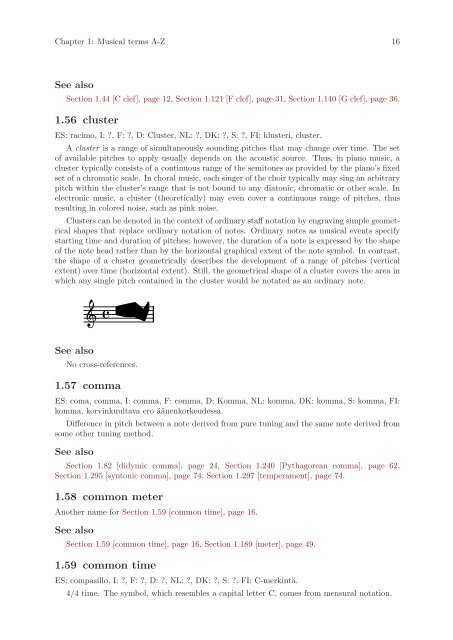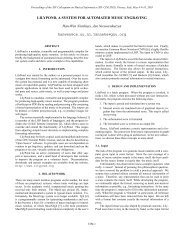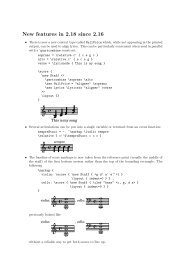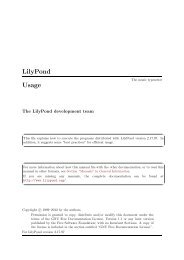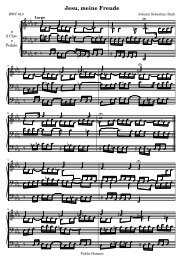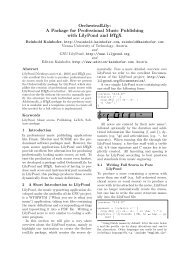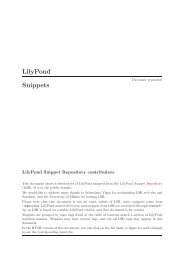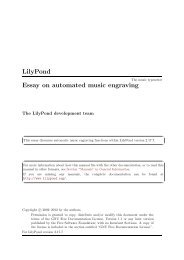Section “slur” in Music Glossary - LilyPond
Section “slur” in Music Glossary - LilyPond
Section “slur” in Music Glossary - LilyPond
Create successful ePaper yourself
Turn your PDF publications into a flip-book with our unique Google optimized e-Paper software.
Chapter 1: <strong>Music</strong>al terms A-Z 16<br />
See also<br />
<strong>Section</strong> 1.44 [C clef], page 12, <strong>Section</strong> 1.121 [F clef], page 31, <strong>Section</strong> 1.140 [G clef], page 36.<br />
1.56 cluster<br />
ES: racimo, I: ?, F: ?, D: Cluster, NL: ?, DK: ?, S: ?, FI: klusteri, cluster.<br />
A cluster is a range of simultaneously sound<strong>in</strong>g pitches that may change over time. The set<br />
of available pitches to apply usually depends on the acoustic source. Thus, <strong>in</strong> piano music, a<br />
cluster typically consists of a cont<strong>in</strong>uous range of the semitones as provided by the piano’s fixed<br />
set of a chromatic scale. In choral music, each s<strong>in</strong>ger of the choir typically may s<strong>in</strong>g an arbitrary<br />
pitch with<strong>in</strong> the cluster’s range that is not bound to any diatonic, chromatic or other scale. In<br />
electronic music, a cluster (theoretically) may even cover a cont<strong>in</strong>uous range of pitches, thus<br />
result<strong>in</strong>g <strong>in</strong> colored noise, such as p<strong>in</strong>k noise.<br />
Clusters can be denoted <strong>in</strong> the context of ord<strong>in</strong>ary staff notation by engrav<strong>in</strong>g simple geometrical<br />
shapes that replace ord<strong>in</strong>ary notation of notes. Ord<strong>in</strong>ary notes as musical events specify<br />
start<strong>in</strong>g time and duration of pitches; however, the duration of a note is expressed by the shape<br />
of the note head rather than by the horizontal graphical extent of the note symbol. In contrast,<br />
the shape of a cluster geometrically describes the development of a range of pitches (vertical<br />
extent) over time (horizontal extent). Still, the geometrical shape of a cluster covers the area <strong>in</strong><br />
which any s<strong>in</strong>gle pitch conta<strong>in</strong>ed <strong>in</strong> the cluster would be notated as an ord<strong>in</strong>ary note.<br />
See also<br />
<br />
No cross-references.<br />
1.57 comma<br />
ES: coma, comma, I: comma, F: comma, D: Komma, NL: komma, DK: komma, S: komma, FI:<br />
komma, korv<strong>in</strong>kuultava ero äänenkorkeudessa.<br />
Difference <strong>in</strong> pitch between a note derived from pure tun<strong>in</strong>g and the same note derived from<br />
some other tun<strong>in</strong>g method.<br />
See also<br />
<strong>Section</strong> 1.82 [didymic comma], page 24, <strong>Section</strong> 1.240 [Pythagorean comma], page 62,<br />
<strong>Section</strong> 1.295 [syntonic comma], page 74, <strong>Section</strong> 1.297 [temperament], page 74.<br />
1.58 common meter<br />
Another name for <strong>Section</strong> 1.59 [common time], page 16.<br />
See also<br />
<strong>Section</strong> 1.59 [common time], page 16, <strong>Section</strong> 1.189 [meter], page 49.<br />
1.59 common time<br />
ES: compasillo, I: ?, F: ?, D: ?, NL: ?, DK: ?, S: ?, FI: C-merk<strong>in</strong>tä.<br />
4/4 time. The symbol, which resembles a capital letter C, comes from mensural notation.


